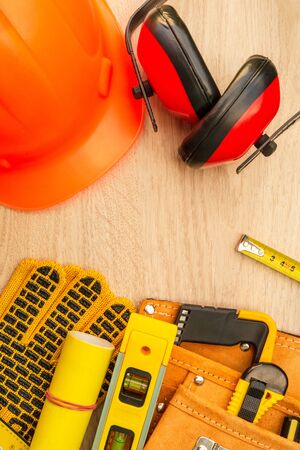Understanding UK Health & Safety Regulations
Before embarking on any home renovation project in the UK, it is crucial for homeowners to familiarise themselves with the nation’s comprehensive health and safety framework. The UK has specific laws and guidelines designed to ensure that both property owners and contractors maintain a safe environment during renovations. These regulations are not only about compliance—they’re about protecting lives, safeguarding investments, and fostering responsible stewardship of Britain’s rich architectural heritage.
Essential Legislation at a Glance
| Regulation | Description | Applies To |
|---|---|---|
| Health and Safety at Work Act 1974 | The cornerstone of workplace safety in the UK, this act covers obligations for anyone managing a renovation site, including homeowners overseeing major works. | All renovation projects involving tradespeople or significant works |
| Construction (Design and Management) Regulations 2015 (CDM) | Focuses on planning and managing safety throughout the entire project lifecycle, placing clear responsibilities on clients (including homeowners), designers, and contractors. | Projects involving more than one contractor or lasting over 30 working days |
| Control of Asbestos Regulations 2012 | Mandates safe handling and removal of asbestos-containing materials often found in older UK properties. | Properties built before 2000 |
| Building Regulations 2010 (as amended) | Lays out standards for structural safety, fire protection, electrical installations, and ventilation to ensure habitable spaces are both safe and efficient. | All building work requiring approval from local authorities |
Navigating Local Authority Requirements
Local councils across England, Scotland, Wales, and Northern Ireland may have additional requirements or permit procedures for certain types of works. Homeowners should always consult their local authority’s planning department before commencing any project to ensure all necessary permissions are secured. This proactive approach not only keeps your project legal but also provides peace of mind as you transform your living space with confidence and care.
2. Identifying and Managing Asbestos and Hazardous Materials
Renovating older British properties often reveals a legacy of materials now known to be hazardous. Key among these are asbestos, lead-based paint, and other chemicals once common in construction. Understanding how to identify and safely manage these substances is essential for homeowners looking to protect both their health and the integrity of their property.
Spotting Common Hazardous Materials in UK Homes
Many homes built before 2000 may contain asbestos in ceiling tiles, pipe lagging, roofing felt, or textured coatings such as Artex. Lead paint is prevalent in pre-1960s properties, especially on skirting boards, windowsills, and doors. Other risks can include old insulation types and certain adhesives.
| Material | Common Locations | Years Used |
|---|---|---|
| Asbestos | Ceilings, water tanks, pipe lagging, floor tiles, garage roofs | Pre-2000 |
| Lead Paint | Woodwork (doors, frames), metal railings, interior walls | Pre-1960s mainly |
| Bitumen Adhesives | Flooring underlay, roof felt | Pre-1980s |
Key Strategies for Safe Handling
- Conduct Professional Surveys: Before beginning any renovation work, commission an accredited asbestos surveyor or environmental consultant. They will identify potential hazards and advise on next steps.
- Avoid Disturbance: Never sand, drill, or strip suspected asbestos or lead paint yourself. Disturbance releases dangerous fibres and dust into the air.
- Use Licensed Contractors: Removal or encapsulation of hazardous materials should only be done by HSE-licensed professionals who follow strict safety protocols.
Disposal and Legal Obligations
The UK has stringent regulations for disposing of hazardous waste. Homeowners must ensure that all removal is documented and disposed of at approved facilities—your local council can provide guidance. Failing to comply may result in heavy fines or prosecution.
Aesthetic Considerations During Remediation
If hazardous materials are discovered during your renovation journey, consider incorporating new design elements that reflect modern safety while honouring the historic character of your home. For example, replacing old pipe lagging with contemporary finishes not only ensures safety but also refreshes the visual appeal of your interiors.
![]()
3. Electrical and Gas Safety Standards
When embarking on a home renovation project in the UK, ensuring the safety and compliance of electrical and gas installations is absolutely essential. Not only do these standards safeguard your property and those within it, but they are also legally mandated, carrying significant implications if overlooked.
The Importance of Certified Professionals
It is a legal requirement in the UK that all electrical work in domestic properties is carried out by a registered electrician who is certified under schemes such as NICEIC or NAPIT. Similarly, any gas-related works must be conducted by a Gas Safe registered engineer. These professionals possess up-to-date knowledge of British Standards and Building Regulations, guaranteeing that installations are both safe and compliant.
Proper Installations & Regular Inspections
Improperly installed or maintained electrical and gas systems can lead to serious hazards, including fire, carbon monoxide poisoning, or even fatalities. To mitigate these risks, regular inspections and testing should be scheduled before, during, and after renovations. All new installations or significant alterations require certification upon completion.
UK Compliance Checks: Key Requirements
| Aspect | Who Can Perform? | Required Certification |
|---|---|---|
| Electrical Installations | NICEIC/NAPIT Registered Electrician | EICR (Electrical Installation Condition Report) |
| Gas Work (Boilers, Appliances) | Gas Safe Registered Engineer | Gas Safety Certificate (CP12) |
| Alterations to Existing Systems | Certified Specialist | Building Regulation Compliance Certificate |
Ensuring Peace of Mind During Renovations
Engaging qualified experts from the outset not only ensures all work meets UK regulations but also gives homeowners peace of mind knowing their environment is safe for family and visitors alike. Never be tempted to cut corners with DIY attempts on electrical or gas systems—professional oversight is a non-negotiable aspect of responsible renovation in Britain.
4. Safe Waste Disposal and Environmental Practices
During property renovations in the UK, responsible waste management is not only a matter of good practice but also a legal requirement. Homeowners must be aware of the correct methods for handling and disposing of various building materials to ensure safety and environmental sustainability. The improper disposal of construction waste can lead to significant fines and damage to local ecosystems.
Understanding Legal Responsibilities
According to UK regulations, homeowners are legally obliged to dispose of renovation waste responsibly. This includes adhering to the Duty of Care under the Environmental Protection Act 1990, which requires all waste to be handled by licensed carriers and disposed of at authorised facilities. Fly-tipping or illegal dumping is a serious offence with hefty penalties.
Sorting Waste Materials
Efficient sorting of renovation waste not only simplifies recycling but also minimises landfill impact. The table below outlines common types of renovation waste and their recommended disposal routes:
| Material Type | Recommended Disposal/Recycle Method |
|---|---|
| Bricks & Rubble | Take to local council recycling centre (hardcore skip) |
| Timber & Wood | Reuse, donate, or recycle via wood recycling services |
| Metals | Recycle at scrap metal facilities |
| Plastics | Check local council guidelines; some plastics recyclable at specific centres |
| Painters & Solvents | Dispose at hazardous waste collection points |
Embracing Sustainable Practices
Sustainability is increasingly important in UK home renovations. Where possible, prioritise reusing existing materials or sourcing reclaimed items to reduce environmental impact. Many local charities welcome donations of surplus materials such as tiles, doors, or fixtures.
Engaging Licensed Waste Carriers
Always check that any hired waste removal service is registered with the Environment Agency. Request a waste transfer note for your records—this proves you have met your legal obligations if questioned later.
Quick Tips for Responsible Waste Management:
- Plan ahead by estimating quantities and arranging skip hire early
- Avoid burning waste; it is illegal and harmful to air quality
- Consult your local authority for guidance on specialist disposal (e.g., asbestos)
By following these practices, UK homeowners can ensure their renovation projects protect both people and the environment while staying firmly within the law.
5. Protecting Occupants and Neighbours During Works
When embarking on home renovations in the UK, it’s vital to uphold both safety and good neighbourly relations. The process can be disruptive, but with thoughtful planning and implementation of health and safety measures, you can reduce risks for your household and those living nearby. Below are key strategies to maintain a harmonious environment during your renovation project.
Minimising Accidents Within the Home
Ensuring a safe space for family members, pets, and visitors is paramount. Designate clear boundaries between work zones and living areas using temporary barriers or dust sheets. Always store tools and hazardous materials securely out of reach. Encourage contractors to adhere strictly to site tidiness, preventing trip hazards from offcuts, cables, or debris.
Reducing Dust and Airborne Hazards
Renovation works often generate significant dust, which can pose respiratory risks and impact wellbeing. Use dust extraction equipment where possible, especially when sanding or cutting materials. Close doors to non-work areas and cover furniture with protective sheeting. Ventilate spaces by opening windows away from the worksite direction.
Effective Dust Management Methods
| Method | Description |
|---|---|
| Dust Barriers | Install plastic sheeting or zip walls to separate renovation zones |
| Extraction Units | Utilise HEPA-filtered vacuums attached to power tools |
| Dampening Techniques | Spray water on surfaces before cutting or drilling to suppress dust |
Managing Noise Considerately
Noisy construction activities can cause tension within your household and with neighbours. Schedule high-noise tasks during reasonable hours—typically 8am to 6pm on weekdays—and notify neighbours in advance if particularly disruptive work is planned. Consider using quieter hand tools when possible, and request that tradespeople avoid loud radios or shouting on site.
Civic Courtesy Checklist
- Display contact details for the site manager on your property boundary in case neighbours need to raise concerns
- Avoid parking construction vehicles in ways that block driveways or access roads
- Sweep pavements daily to remove debris migrating from the site
Maintaining Community Relations
Keeping communication channels open fosters goodwill. A simple courtesy letter informing neighbours about the scope and timeline of your project can go a long way. Respond promptly to any issues raised, demonstrating your commitment to being a responsible member of your local community throughout the renovation process.
6. Insuring Your Property During Renovation
Ensuring your property is properly insured during renovation is an essential step for every UK homeowner embarking on a project. While standard home insurance may seem sufficient, most policies do not cover risks associated with building works. Instead, tailored insurance solutions are necessary to protect your investment and manage unforeseen incidents.
Types of Insurance Cover for UK Renovations
There are three primary types of insurance coverage you should consider when renovating:
| Type of Cover | What It Protects | Why Its Essential |
|---|---|---|
| Building Insurance | Covers structural damage to the property caused by events like fire, flood, or storm during works. | Standard home policies may be void during renovations; specialised cover ensures ongoing protection. |
| Public Liability Insurance | Covers injury or damage to third parties (e.g., neighbours, passers-by) as a result of renovation activities. | A legal requirement for many contractors; vital for homeowners if managing their own projects or employing trades directly. |
| Accidental Damage Insurance | Covers unintentional damage caused by you, your family, or contractors during renovation. | Helps manage costs from mishaps like broken windows, damaged pipes, or accidental structural harm. |
Tailoring Your Policy to the Project
The extent and type of cover required will depend on the scale and nature of your renovation. For example, listed buildings or properties in conservation areas may need specialist policies due to strict regulations and higher restoration costs. Always inform your insurer before starting any work; failing to do so could render existing policies invalid.
Key Takeaway
Selecting appropriate insurance is not just about compliance—its about peace of mind. Consult with UK-based brokers who understand local requirements and can advise on bespoke packages that suit both your property and your project plans. Remember: investing in comprehensive cover now can save significant stress and financial loss later.


